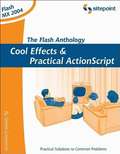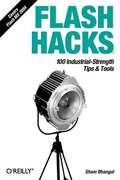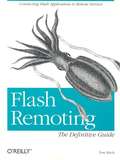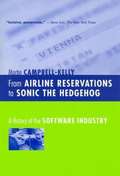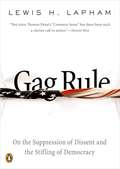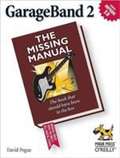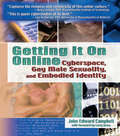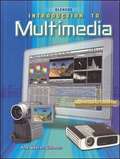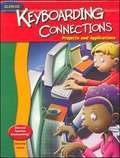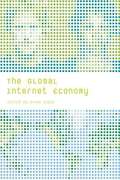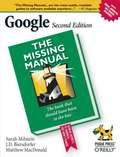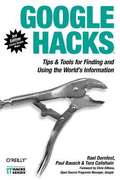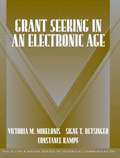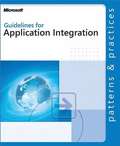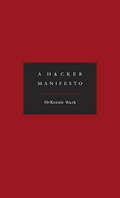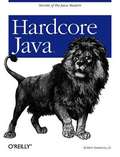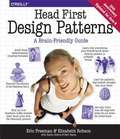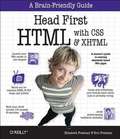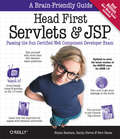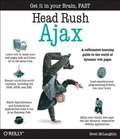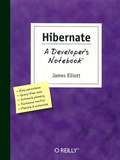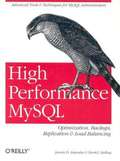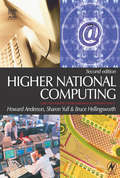- Table View
- List View
The Flash Anthology
by Steven GrosvenorA practical and fun Flash book that shows readers over 60 practical techniques, solutions and cool effects to instantly use on their Website or project. The Flash Anthology makes an excellent task reference or it can be used for inspiration for future projects. The book tackles the majority of the most common building blocks for real world Flash applications-as one reviewer described "it covers everything that Flash does best". Topics covered include working with external data, debugging, animation, sound and video effects, flash forms and getting indexed by search engines. All the solutions are based on ActionScript, are completely customizable and come with suggested modifications. Examples are compatible with ActionScript 2 and Flash MX 2004.
Flash Hacks
by Sham BhangalIf you've ever seen an especially cool Flash effect on the web, gone straight to your trusty Flash book to find out how to do it, then turned away empty-handed-- Flash Hacks is for you. This unique book offers a collection of expert Flash tips and tricks for optimization, creating interesting effects, ActionScript programming, sound and video effects, and much more--and you don't need to be an expert to use them (although you'll certainly look like one). With Flash technology, you can create compelling web content, expressive user interfaces, and rich applications for the Internet--all of which dramatically enhance the user experience. But Flash is not just practical, it's a wellspring of opportunities to unleash your creativity and have fun. Flash Hacks dives straight into all that's fun and creative about Flash, while presenting useful programming techniques and practical--although never mundane--hacks that can make your work easier. Geared to cover Flash MX, Flash MX 2004, and Flash MX Professional 2004, Flash Hacks begins with hacks on authoring, testing, and web environments. You'll learn how to beat the Flash bloat bug, realistically simulate the web, create a JavaScript-free Flash sniffer, and hack a spellchecker for Flash. Other hacks in the book are grouped in the following areas: Primitives Timelines Symbols Flash Assets (sound, video, and bitmaps) Code hacks Events and event handling Advanced animation UI design hacks True to O'Reilly's popular Hacks series, Flash Hacks tackles problems and solutions that aren't dealt with elsewhere. You'll pick up insider tips from the experts, and learn about amazing and sometimes quirky aspects of Flash. If you want more than your average Flash user--you want to explore and experiment, unearth shortcuts, create useful tools, and come up with fun things to try on your own-- Flash Hacks is the book you'll need.
Flash Remoting: The Definitive Guide
by Tom MuckFlash Remoting MX lets developers easily integrate rich Macromedia Flash content with applications that are built using Macromedia ColdFusion MX, Microsoft .NET, Java, PHP, or SOAP-based web services. The result is complex client/server applications that more closely resemble desktop applications than traditional web pages. Gone is the click/wait/reload approach of HTML. Your web application uses Flash as the front end while Flash Remoting handles the communication behind the scenes with the application server. All the end user knows is that it's fast and flexible. The potential uses for Flash Remoting are endless. Flash Remoting: The Definitive Guide will help you understand this breakthrough technology and use it to build your own Rich Internet Applications (RIAs). Build applications that connect to a database, file system, or other server-side technologies. Or, use Flash Remoting to create: online stores that feature catalogs and shopping cart systems sound and video clip libraries banner ads with built-in shopping carts, click-through tracking, and site search capabilities new controls that can be used in place of HTML extensions to Flash, Dreamweaver, Fireworks, and more front-ends to databases for administrators The book begins with Flash Remoting basics: setup, installation and an introduction to its underlying concepts. Next, you'll explore the Flash's User Interface components as they relate to Flash Remoting. Then, you'll gain insights into Flash Remoting internals and the Remoting API. The book is rich with examples that you will be able to run on your own system. The next section focuses on the server-side environment that you'll use for your applications. Individual chapters cover Flash Remoting with ColdFusion, Server-Side ActionScript, Java, ASP.NET, and PHP. The last section covers more advanced Flash Remoting techniques, such as calling web services from Flash Remoting, extending objects and UI controls, best practices, and debugging. Plus there is a detailed chapter demonstrating a real-world application. The book concludes with a Flash Remoting API reference. Developers who are looking to create Rich Internet Applications with Flash will find Flash Remoting: The Definitive Guide indispensable.
Fools Rush In: Steve Case, Jerry Levin, and the Unmaking of AOL Time Warner
by Nina MunkA carefully explained business debacle.
From Airline Reservations to Sonic the Hedgehog: A History of the Software Industry
by Martin Campbell-KellyFrom its first glimmerings in the 1950s, the software industry has evolved to become the fourth largest industrial sector of the US economy. Starting with a handful of software contractors who produced specialized programs for the few existing machines, the industry grew to include producers of corporate software packages and then makers of mass-market products and recreational software. This book tells the story of each of these types of firm, focusing on the products they developed, the business models they followed, and the markets they served. By describing the breadth of this industry, Martin Campbell-Kelly corrects the popular misconception that one firm is at the center of the software universe. He also tells the story of lucrative software products such as IBM's CICS and SAP's R/3, which, though little known to the general public, lie at the heart of today's information infrastructure. With its wealth of industry data and its thoughtful judgments, this book will become a starting point for all future investigations of this fundamental component of computer history.
Gag Rule: On the Suppression of Dissent and the Stifling of Democracy
by Lewis LaphamLapham issues a call to action in defense of one of our most important liberties--the right to raise our voices against the powers that be and have those voices heard.
GarageBand 2: The Missing Manual
by David PogueWhether you're a professional musician or a mere novice, Apple's GarageBand software has everything you need to produce commercial-quality recordings entirely on your own. Just imagine how many thousands of singers and instrumentalists remain undiscovered because they lack the capability to produce viable demos. Well, no more. Now there's no need to assemble a backup band or book time at a professional studio--GarageBand has it covered. And GarageBand 2: The Missing Manual gives you the know-how you need to make it all happen. It's an authoritative, witty guide to constructing digital recordings with GarageBand. Written by the master of the Missing Manual series, and a musician himself, David Pogue, this top-selling book shows you how to maximize the program's entire set of tools. Pre-recorded loops, sampled sounds, live recordings--they're all explained in easy-to-understand language. It also shows you how to apply professional-sounding effects like reverb or chorusing, and then export the finished product to iTunes, where you can download your work to an iPod, export it as an MP3, or burn it onto CDs. Now revised to reflect GarageBand's latest features, this book's second edition also addresses how to: use GarageBand's eight-track capabilities display music notation in real time enhance timing and pitch for better quality recordings change the tempo and key of recorded instruments tune guitars with GarageBand before recording So if you're chasing a dream or just having fun, GarageBand 2: The Missing Manual is the only resource you need to make the finest musical recordings possible.
Getting It On Online: Cyberspace, Gay Male Sexuality, and Embodied Identity
by John Edward CampbellLearn how gay men use Internet technologies to connect with others sharing their erotic desires and to forge affirming communities online! Getting It On Online: Cyberspace, Gay Male Sexuality, and Embodied Identity examines the online embodied experiences of gay men. At once scholarly and sensual, this unique book is the result of a three-year ethnographic study chronicling the activities on three distinct social scenes in the world of Internet Relay Chat (IRC)-virtual spaces constructed by gay men for the erotic exploration of the male body. Examining the vital role the body plays in defining these online spaces offers insight into how gay men negotiate their identities through emerging communication technologies. The author combines a critical look at the role of the body in cyberspace with candid accounts of his own online experiences to challenge conventional views on sex, sexuality, and embodied identity. Getting It On Online provides an inside look at three specific online communities-gaychub (a community celebrating male obesity), gaymuscle (a community formulated around images of the muscular male body), and gaymusclebears (a space representing the erotic convergence of the obese and muscular male bodies emerging out of the gay male "bear" subculture)-in an effort to unsettle those models of beauty and the erotic depicted in more mainstream media. The book demonstrates how the social position of these men in the physical world in regards to age, race, gender, class, and physical beauty influences their online experiences. Far from a realm of bodiless exultation, Getting It On Online illustrates how the flesh remains very much present in cyberspace. Getting It On Online examines topics such as: why people chat online the history of IRC (Internet Relay Chat) how people construct their identities in cyberspace how some online spaces function like virtual gay bars the concept of online disembodiment the role the body plays in online social relations the future of online communication ethnographic research in cyberspace mediated images of the male body and the gay male beauty myth and much more! Getting It On Online: Cyberspace, Gay Male Sexuality, and Embodied Identity is an essential resource for anthropologists, sociologists, and psychologists; academics working in gender studies, queer theory, cultural studies, and cyber-culture studies; and anyone interested in gay and lesbian issues and/or cyberspace.
Glencoe Introduction To Multimedia
by Ana Weston SolomonIntroduction to Multimedia is designed to help you become a skilled and creative user of current multimedia technology. The purpose of this course is to increase your understanding of multimedia concepts and techniques. You are the reason that this textbook was written. Multimedia is a vast and exciting domain.
Glencoe Keyboarding Connections: Projects and Applications
by Julie Jaehne Arlene ZimmerlyStudents will learn keyboarding and complete numerous hands-on projects related to word processing, desktop publishing, presentation software, spreadsheets, and databases. The text was written for middle school students. All activities and projects are age-appropriate. Keyboarding Connections features a "fun" format complemented by a visually appealing game-like software interface. High-interest skill building exercises, applications, and games consistently hold students' attention. All new content includes extensive practice with e-mail, PowerPoint®, and Web page design. An Internet Connection feature provides search tips and relevant links. A user-friendly Web site features include State correlations, language arts activities, and additional teacher resources. Plus, everything is Windows 2000 and XP compatible!
The Global Internet Economy
by Bruce KogutThe intertwining of the Internet and the globalization of finance, corporate governance, and trade raises questions about national models of technology development and property rights.
Google: The Missing Manual, 2nd Edition
by Matthew Macdonald Rael Dornfest J. D. Biersdorfer Sarah MilsteinGoogle.com is one of the most popular sites on the Internet and is used around the world by millions of people every day. Sure, you know how to "Google it" when you're searching for something--anything!--on the Web. It's plenty fast and easy to use. But did you know how much more you could achieve with the world's best search engine by clicking beyond the "Google Search" button? While you can interface with Google in 97 languages and glean results in 35, you can't find any kind of instruction manual from Google. Lucky for you, our fully updated and greatly expanded second edition to the bestselling Google: The Missing Manual covers everything you could possibly want to know about Google, including the newest and coolest--and often most underused (what is Froogle, anyway?)--features. There's even a full chapter devoted to Gmail, Google's free email service that includes a whopping 2.5 GB of space). This wise and witty guide delivers the complete scoop on Google, from how it works to how you can search far more effectively and efficiently (no more scrolling through 168 pages of seemingly irrelevant results); take best advantage of Google's lesser-known features, such as Google Print, Google Desktop, and Google Suggest; get your website listed on Google; track your visitors with Google Analytics; make money with AdWords and AdSense; and much more. Whether you're new to Google or already a many-times-a-day user, you're sure to find tutorials, tips, tricks, and tools that take you well beyond simple search to Google gurudom.
Google Hacks, 3rd Edition
by Paul Bausch Tara Calishain Rael DornfestEveryone knows that Google lets you search billions of web pages. But few people realize that Google also gives you hundreds of cool ways to organize and play with information. Since we released the last edition of this bestselling book, Google has added many new features and services to its expanding universe: Google Earth, Google Talk, Google Maps, Google Blog Search, Video Search, Music Search, Google Base, Google Reader, and Google Desktop among them. We've found ways to get these new services to do even more. The expanded third edition of Google Hacks is a brand-new and infinitely more useful book for this powerful search engine. You'll not only find dozens of hacks for the new Google services, but plenty of updated tips, tricks and scripts for hacking the old ones. Now you can make a Google Earth movie, visualize your web site traffic with Google Analytics, post pictures to your blog with Picasa, or access Gmail in your favorite email client. Industrial strength and real-world tested, this new collection enables you to mine a ton of information within Google's reach. And have a lot of fun while doing it: Search Google over IM with a Google Talk bot Build a customized Google Map and add it to your own web site Cover your searching tracks and take back your browsing privacy Turn any Google query into an RSS feed that you can monitor in Google Reader or the newsreader of your choice Keep tabs on blogs in new, useful ways Turn Gmail into an external hard drive for Windows, Mac, or Linux Beef up your web pages with search, ads, news feeds, and more Program Google with the Google API and language of your choice For those of you concerned about Google as an emerging Big Brother, this new edition also offers advice and concrete tips for protecting your privacy. Get into the world of Google and bend it to your will!
Grant Seeking in an Electronic Age (Technical Communication Ser.)
by Victoria M. Mikelonis Signe T. Betsinger Constance KampfThis guide teaches students and professionals a systematic process for researching, designing, writing, and submitting successful grant-seeking proposals. <P><P>Focusing on proposals submitted for government, foundation, and corporation funding, Grant Seeking in an Electronic Age leads the reader through a six-step grant-seeking process, from researching potential funders, to designing, writing and submitting a proposal that follows the funder's guidelines. Grounded in theory, but rooted in successful practice, it teaches students what really works–a third of students who submit proposals based on this text's approach get funded within a year. The text's guided discovery process provides a useful framework for novice writers while its thinking-planning exercises offer useful ways of organizing information and discovering what still need to be researched.
Guided Flight Discovery: Instrument/Commercial Textbook
by Jeppesen SandersonJeppesen's Guided Flight Discovery Instrument/Commercial textbook provides the most complete explanations of aeronautical concepts for pilots pursuing a instrument rating or commercial certificate. This colorful textbook is your primary source for initial study and review. It includes the Principles of Instrument Flight, The Flight Environment, Instrument Charts and Procedures, Aviation Weather and IFR Flight Operations and Commercial Pilot Operations, as well as an introductory look at Building Professional Experience. The most comprehensive and visually appealing Instrument/Commercial textbook ever! The Instrument/Commercial textbook is your primary source for initial study and review to achieve an instrument rating or commercial pilot certificate. The intuitive organization and colorful presentation of the manual will help you learn quickly from the start. The text contains complete and concise explanations of the advanced concepts and ideas that every instrument and commercial pilot needs to know with the subjects arranged in a logical manner to build upon previously introduced topics. You can expand your knowledge of specific subjects and the world of aviation by exploring the Discovery Insets, which are strategically placed throughout the chapters. To help you understand how your mind and body function while you fly, human factors principles are presented in Human Element Insets. Throughout the manual, concepts that directly relate to FAA test questions are described in FAA Question Insets. To help you effectively review material, key terms are highlighted throughout the text and listed at the end of each section along with a checklist, which summarizes important concepts. Additionally, you can evaluate your understanding of material by completing the associated questions at the end of each section. Jeppesen Part Number JS314520
Guidelines for Application Integration
by Microsoft CorporationExtend your existing technology investments--and increase your organization's agility--by integrating disparate applications and data into solutions that work together to meet ever-evolving business needs. This guide defines application integration and describes the requirements, capabilities, and best practices to help you achieve success. It is written for technical decision makers and architects looking for practical recommendations on how to orchestrate an application integration project that puts heterogeneous and legacy applications to work--helping to maximize ROI and organizational responsiveness. PATTERNS & PRACTICES guides are reviewed and approved by Microsoft engineering teams, consultants, partners, and customers--delivering accurate, real-world information that's been technically validated and tested.
A Hacker Manifesto
by McKenzie WarkA double is haunting the world—the double of abstraction, the virtual reality of information, programming or poetry, math or music, curves or colorings upon which the fortunes of states and armies, companies and communities now depend. The bold aim of this book is to make manifest the origins, purpose, and interests of the emerging class responsible for making this new world—for producing the new concepts, new perceptions, and new sensations out of the stuff of raw data. A Hacker Manifesto deftly defines the fraught territory between the ever more strident demands by drug and media companies for protection of their patents and copyrights and the pervasive popular culture of file sharing and pirating. This vexed ground, the realm of so-called “intellectual property,” gives rise to a whole new kind of class conflict, one that pits the creators of information—the hacker class of researchers and authors, artists and biologists, chemists and musicians, philosophers and programmers—against a possessing class who would monopolize what the hacker produces. Drawing in equal measure on Guy Debord and Gilles Deleuze, A Hacker Manifesto offers a systematic restatement of Marxist thought for the age of cyberspace and globalization. In the widespread revolt against commodified information, McKenzie Wark sees a utopian promise, beyond the property form, and a new progressive class, the hacker class, who voice a shared interest in a new information commons.
Hardcore Java
by Robert Simmons JrJava has quickly become one of the most important languages in programming, particularly for professional and enterprise-level projects. From its infancy as a language primarily used for web applets to its maturity through servlets, Enterprise JavaBeans, and database access, Java has become a complex and robust tool for today's developer. Hardcore Java takes this language and breaks it apart, piece by piece, revealing the important secrets and tricks that will take you from a junior-level programmer to a seasoned and expert developer. You'll fly through the fundamentals and quickly find yourself learning about advanced memory management techniques, optimization and bytecode-level enhancements, and the techniques required to build lightning-fast GUIs. Throughout the book, you'll also master the art of writing and maintaining bulletproof and error-proof code, all while grasping the intricacies of the Java language. Hardcore Java covers: Use of the final keyword to optimize and protect your Java classes. Complete and thorough coverage of all types of nested classes, including how to optimize anonymous and inner classes. Detailed discussion of immutable objects, including unique tips on when to use them (and when not to). Elimination of bugs through exception-handling management. In-depth studies of constants, including their impact on the Java memory model. The most thorough discussion of reflection in print, moving far beyond other books' "Hello World" coverage. Construction and use of dynamic proxies, in both Java Standard and Enterprise editions. Expansive coverage of weak references, including usage patterns and their role in garbage collection and memory management. Hardcore Java is an invaluable addition to every programmer's library, and even the most advanced developers will find themselves moving beyond their own conceptions into truly advanced applications of the language. Thousands of lines of code, heavily commented and easily runnable, illustrate each concept in the book.
Head First Design Patterns
by Bert Bates Elisabeth Freeman Eric Freeman Kathy SierraYou're not alone. At any given moment, somewhere in the world someone struggles with the same software design problems you have. You know you don't want to reinvent the wheel (or worse, a flat tire), so you look to Design Patterns--the lessons learned by those who've faced the same problems. With Design Patterns, you get to take advantage of the best practices and experience of others, so that you can spend your time on...something else. Something more challenging. Something more complex. Something more fun. You want to learn about the patterns that matter--why to use them, when to use them, how to use them (and when NOT to use them). But you don't just want to see how patterns look in a book, you want to know how they look "in the wild". In their native environment. In other words, in real world applications. You also want to learn how patterns are used in the Java API, and how to exploit Java's built-in pattern support in your own code. You want to learn the real OO design principles and why everything your boss told you about inheritance might be wrong (and what to do instead). You want to learn how those principles will help the next time you're up a creek without a design paddle pattern. Most importantly, you want to learn the "secret language" of Design Patterns so that you can hold your own with your co-worker (and impress cocktail party guests) when he casually mentions his stunningly clever use of Command, Facade, Proxy, and Factory in between sips of a martini. You'll easily counter with your deep understanding of why Singleton isn't as simple as it sounds, how the Factory is so often misunderstood, or on the real relationship between Decorator, Facade and Adapter. With Head First Design Patterns , you'll avoid the embarrassment of thinking Decorator is something from the "Trading Spaces" show. Best of all, in a way that won't put you to sleep! We think your time is too important (and too short) to spend it struggling with academic texts. If you've read a Head First book, you know what to expect--a visually-rich format designed for the way your brain works. Using the latest research in neurobiology, cognitive science, and learning theory, Head First Design Patterns will load patterns into your brain in a way that sticks. In a way that lets you put them to work immediately. In a way that makes you better at solving software design problems, and better at speaking the language of patterns with others on your team.
Head First HTML with CSS & XHTML
by Elisabeth Freeman Eric FreemanTired of reading HTML books that only make sense after you're an expert? Then it's about time you picked up Head First HTML with CSS & XHTML and really learned HTML. You want to learn HTML so you can finally create those Web pages you've always wanted, so you can communicate more effectively with friends, family, fans and fanatic customers. You also want to do it right so you can actually maintain and expand your Web pages over time, and so your Web pages work in all the browsers and mobile devices out there. Oh, and if you've never heard of CSS, that's okay - we won't tell anyone you're still partying like it's 1999 - but if you're going to create Web pages in the 21st century then you'll want to know and understand CSS. Learn the real secrets of creating Web pages, and why everything your boss told you about HTML tables is probably wrong (and what to do instead). Most importantly, hold your own with your co-worker (and impress cocktail party guests) when he casually mentions how his HTML is now strict, and his CSS is in an external style sheet. With Head First HTML with CSS & XHTML, you'll avoid the embarrassment of thinking Web-safe colors still matter, and the foolishness of slipping a font tag into your pages. Best of all, you'll learn HTML and CSS in a way that won't put you to sleep. If you've read a Head First book, you know what to expect: a visually-rich format designed for the way your brain works. Using the latest research in neurobiology, cognitive science, and learning theory, this book will load HTML, CSS, and XHTML into your brain in a way that sticks. So what are you waiting for? Leave those other dusty books behind and come join us in Webville. Your tour is about to begin. "Elegant design is at the core of every chapter here, each concept conveyed with equal doses of pragmatism and wit." --Ken Goldstein, Executive Vice President, Disney Online "This book is a thoroughly modern introduction to forward-looking practices in web page markup and presentation." --Danny Goodman, author of Dynamic HTML: The Definitive Guide "What used to be a long trial and error learning process has now been reduced neatly into an engaging paperback." --Mike Davidson, CEO, Newsvine, Inc. "I love Head First HTML with CSS & XHTML --it teaches you everything you need to learn in a 'fun coated' format!" --Sally Applin, UI Designer and Artist "I haven't had as much fun reading a book (other than Harry Potter) in years. And your book finally helped me break out of my hapless so-last-century way of creating web pages." --Professor David M. Arnow, Department of Computer and Information Science, Brooklyn College "If you've ever had a family member who wanted you to design a website for them, buy them Head First HTML with CSS and XHTML. If you've ever asked a family member to design you a web site, buy this book. If you've ever bought an HTML book and ended up using it to level your desk, or for kindling on a cold winter day, buy this book. This is the book you've been waiting for. This is the learning system you've been waiting for." --Warren Kelly, Blogcritics.org
Head First Servlets and JSP: Passing the Sun Certified Web Component Developer Exam (Head First)
by Bryan Basham Bert Bates Kathy SierraImagine a world without eBay... unthinkable! How would you get that Farrah Fawcett poster, retired Beanie Baby, or first-edition pet rock? Handling over a gazillion (OK, we exaggerate--it's actually only 1 billion) page views each day, server-side Java makes eBay work. Isn't it time you learned the latest (J2EE 1.4) versions of Servlets and JSPs? This book will get you way up to speed on the technology you'll know it so well, in fact, that you can pass the Sun Certified Web Component Developer (SCWCD) 1.4 exam. If that's what you want to do, that is. Maybe you don't care about the exam, but need to use Servlets and JSPs in your next project. You're working on a deadline. You're over the legal limit for caffeine. You can't waste your time with a book that makes sense only AFTER you're an expert (or worse one that puts you to sleep). No problem. Head First Servlets and JSP's brain-friendly approach drives the knowledge straight into your head (without sharp instruments). You'll interact with servlets and JSPs in ways that help you learn quickly and deeply. It may not be The Da Vinci Code, but quickly see why so many reviewers call it "a page turner". Most importantly, this book will help you use what you learn. It won't get you through the exam only to have you forget everything the next day. Learn to write servlets and JSPs, what makes the Container tick (and what ticks it off), how to use the new JSP Expression Language (EL), what you should NOT write in a JSP, how to write deployment descriptors, secure applications, and even use some server-side design patterns. Can't talk about Struts at a cocktail party? That'll change. You won't just pass the exam, you will truly understand this stuff, and you'll be able to put it to work right away. This new exam is tough--much tougher than the previous version of the SCWCD. The authors of Head First Servlets and JSP know: they created it. (Not that it EVER occurred to them that if they made the exam really hard you'd have to buy a study guide to pass it.) The least they could do is give you a stimulating, fun way to pass the thing. If you're one of the thousands who used Head First EJB to pass the SCWCD exam, you know what to expect!<P> Advisory: Bookshare has learned that this book offers only partial accessibility. We have kept it in the collection because it is useful for some of our members. To explore further access options with us, please contact us through the Book Quality link on the right sidebar. Benetech is actively working on projects to improve accessibility issues such as these.
Head Rush Ajax
by Brett MclaughlinSick of creating web sites that reload every time a user moves the mouse? Tired of servers that wait around to respond to users' requests for movie tickets? It sounds like you need a little (or maybe a lot of) Ajax in your life. Asynchronous programming lets you turn your own websites into smooth, slick, responsive applications that make your users feel like they're back on the information superhighway, not stuck on a dial-up backroad. But who wants to take on next-generation web programming with the last generation's instruction book? You need a learning experience that's as compelling and cutting-edge as the sites you want to design. That's where we come in. With Head Rush Ajax , in no time you'll be writing JavaScript code that fires off asynchronous requests to web servers...and having fun doing it. By the time you've taken your dynamic HTML, XML, JSON, and DOM skills up a few notches, you'll have solved tons of puzzles, figured out how well snowboards sell in Vail, and even watched a boxing match. Sound interesting? Then what are you waiting for? Pick up Head Rush Ajax and learn Ajax and asynchronous programming the right way--the way that sticks. If you've ever read a Head First book, you know what to expect: a visually rich format designed for the way your brain works. Head Rush ramps up the intensity with an even faster look and feel. Have your first working app before you finish Chapter 1, meet up with the nefarious PROJECT: CHAOS stealth team, and even settle the question of the Top 5 Blues CDs of all time. Leave boring, clunky websites behind with 8-tracks and hot pants--and get going with next-generation web programming. "If you thought Ajax was rocket science, this book is for you. Head Rush Ajax puts dynamic, compelling experiences within reach for every web developer." -- Jesse James Garrett, Adaptive Path "A 'technology-meets-reality' book for web pioneers on the cutting edge." -- Valentin Crettaz, CTO, Condris Technologies
Hibernate: A Developer's Notebook
by James ElliottHibernate: A Developer's Notebook shows you how to use Hibernate to automate persistence: you write natural Java objects and some simple configuration files, and Hibernate automates all the interaction between your objects and the database. You don't even need to know the database is there, and you can change from one database to another simply by changing a few statements in a configuration file. If you've needed to add a database backend to your application, don't put it off. It's much more fun than it used to be, and Hibernate: A Developer's Notebook shows you why.
High Performance MySQL
by Derek J. Balling Jeremy ZawodnyIn High Performance MySQL you will learn about MySQL indexing and optimization in depth so you can make better use of these key features. You will learn practical replication, backup, and load-balancing strategies with information that goes beyond available tools to discuss their effects in real-life environments. And you'll learn the supporting techniques you need to carry out these tasks, including advanced configuration, benchmarking, and investigating logs.
Higher National Computing
by Howard Anderson Sharon Yull Bruce HellingsworthHigher National Computing 2e is a new edition of this extremely successful course book, updated specifically to cover the compulsory core units of the 2003 BTEC Higher National Computing schemes. Full coverage is given of the four core units for HNC, the two additional core units required at HND, and the Core Specialist Unit 'Quality Systems', common to both certificate and diploma level.Students following the HNC and HND courses will find this book essential reading, as it covers the core material they will be following through the duration of their course. Knowledge-check questions and activities are included throughout, resulting in a clear and straightforward text which encourages independent study.Like the syllabus itself, this book is ideal for students progressing to HNC / HND from GNVQs, as well as A-Level and BTEC National, with content designed to cover the requirements of students following General Computing, Software Engineering and Business IT courses.
